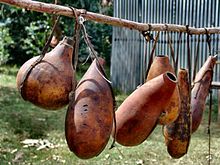Calabash
A calabash , more rarely a calabash , is a vessel primarily intended for the storage and transport of liquids , which is made from the hollowed out and dried shell of the bottle gourd , the calabash . In addition, the hollowed-out pumpkin also serves as a sound box for musical instruments.
This pumpkin is one of the oldest cultivated plants in the world and has been known in many cultures since ancient times. It particularly thrives in tropical and subtropical areas. In Central Europe , bottle gourd varieties presumably originating in Africa were already cultivated before the American pumpkins, which are very common today. The original form can no longer be found, but seeds have been found from South America and Thailand from around 6000 to 12000 BC. Known.
Manufacturing
In order to be able to use the fruits , more precisely berries , of the bottle gourd plant as a vessel, the gourds have to ripen and then slowly air-dry. As a result, a hard, water-impermeable and woody outer skin is formed from the otherwise fleshy fruit shell of the pumpkin, which can be decorated with carvings, paint or fire painting and notches.
use
A circular calabash is stable when filled as long as the filling level is below the radius of the curvature of the bottom. In many gourds the bottom at the location of is ovary curved flat, which ensures a certain stability. Otherwise, the vessels are set up with the help of a fabric ring placed underneath or hung on a string.
In the western culture, the importance of the calabash as a vessel was suppressed by industrially manufactured containers. In many tropical countries, traditional and fully compostable containers are still made from the fruits.
Examples of the regionally different uses of dried fruits:
Vessels
- Drinking vessels
- Mate tea , a popular drink in South America , is consumed with a bombilla from a calabash.
- In Africa, domestic beers such as Dolo in Burkina Faso, Pombe in East Africa and Merisa in Sudan are usually served in calabash half-cups. This custom is also becoming a trend in German restaurants, where the imported fruit brew is traditionally served in calabashes.
- In the past, long, hollowed-out gourds were used as skimmers for wines and the like.
- With the East African Maasai , calabashes are used to store water, milk and cattle blood, which is also used as food. In their Maa language , they differentiate calabashes with a number of words according to size and purpose: oloti (for milk), esingau, engoti, entipi and emala (mostly for sour milk). The latter is the largest calabash with a capacity of three to four liters.
- Vases
- funnel
- Storage vessels (high robustness and salt water resistance)
- Wine lifter (e.g. in Austria and Hungary )
- Medicine vessels in China
Musical instruments

- Drumming in Africa, South America
- some Indian plucking drums
- Music bows in Africa, Asia, South America
- Rattles in Africa like the axatse and the daghumma , in South America the shékere
- Long-necked sitar and vina in India
- Spike fiddle Kabak Kemane in Turkey
- Harp lute kora in West Africa
- Angle harp ardin in mauritania
- Single reed instruments pungi , tarpu and rasem in India
- several Asian mouth organs such as hulusi in China, sumpotan in Borneo and rasem in northeast India
- Natural trumpet waza in Sudan, Ethiopia
- Güiro , Rainmaker
- An upside down in a pool of water floating calabashes half shell serves as a water drum : In Tende - Music in the north of Niger is the whipped with plastic sandals percussion instrument assekalabo . The Fulani one is gedundung played with sticks. The Malinke water drum ji dunu is beaten with two halves of small long-necked calabashes, which are otherwise used as ladles.
- Balafon is a xylophone with calabashes as a resonance body.
- Chipeni is a "singing pumpkin". Some ethnic groups in the Katanga province in the Congo blow into a large calabash and use their lips to create sounds like a trumpet. With one hand they simultaneously beat the rhythm sideways.
Other uses
- Nesting box for birds (in North America for swallows )
- Masks (oceania)
- Tobacco pipe with sepiolite insert (synonym: meerschaum )
- Cages (China - cricket cages and bird houses)
- Penis sheath in New Guinea
Mythological meanings of calabashes
In Chinese Feng Shui , special calabashes, so-called hulus , are an important tool to harmonize the flow of the Qì . In China, calabashes are also traditionally a symbol of longevity. B. sent as a motif on New Year's cards.
In Africa, the cucurbits are a symbol of the uterus and fertility of women, partly because of their shape and number of seeds.
In Voodoo , the calabash symbolizes the universe : two equal halves, which are inextricably linked, represent heaven and earth . This also resulted in the cult of serving sweet fruit beer of the DjuDju priests (Ghanaian origins of the voodoo cult) in calabashes.
Others
Drinking vessels are also made from the fruits of the calabash tree ( Crescentia cujete ), which is native to Central America.
The Soccer City , venue for the final 2010 FIFA World Cup in Johannesburg, is called for their architecture popularly calabash.
Web links
Individual evidence
- ^ Fouad N. Ibrahim: The Drinking Ritual among the Maasai. In: Igor de Garine, Valerie de Garine (eds.): Drinking: Anthropological Approaches. (Anthropology of Food and Nutrition) Berghahn Books, Oxford 2001, p. 88


